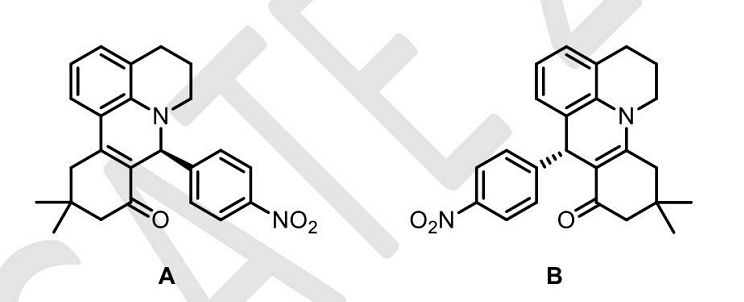Upon addition of compound ( X ) to an aqueous AgNO(_3) solution, a white precipitate appears instantly. Also, ( X ) does not exhibit geometrical isomerism. The CORRECT option(s) for ( X ) is/are:
Show Hint
- ([Cr(OH_2)_4Cl_2]Cl)
- ([Cr(OH_2)_5Cl]Cl_2)
- ([Cr(OH_2)_6]Cl_3)
- ([Cr(OH_2)_3Cl_3])
The Correct Option is B
Solution and Explanation
Step 1: Understanding the reaction with AgNO\(_3\).
When a coordination compound reacts with AgNO\(_3\) to give a white precipitate of AgCl, it indicates the presence of free chloride ions (\(\text{Cl}^-\)) in the solution. The number of such free chloride ions depends on the charge of the coordination complex.
Step 2: Analyzing the options.
- Option (A): \([\text{Cr}(\text{OH}_2)_4\text{Cl}_2]\text{Cl}\)
This compound has 1 free \(\text{Cl}^-\) ion in solution. However, it exhibits geometrical isomerism due to the cis/trans arrangement of the two chlorides within the coordination sphere, so it is incorrect.
- Option (B): \([\text{Cr}(\text{OH}_2)_5\text{Cl}]\text{Cl}_2\)
This compound has 2 free \(\text{Cl}^-\) ions in solution. Since all ligands within the coordination sphere are monodentate and symmetrical, it does not exhibit geometrical isomerism, making this option correct.
- Option (C): \([\text{Cr}(\text{OH}_2)_6]\text{Cl}_3\)
This compound has 3 free \(\text{Cl}^-\) ions in solution. It has no geometrical isomers as all ligands are identical, making this option correct.
- Option (D): \([\text{Cr}(\text{OH}_2)_3\text{Cl}_3]\)
This compound does not have any free \(\text{Cl}^-\) ions in solution, as all chlorides are within the coordination sphere. Moreover, it exhibits geometrical isomerism, making this option incorrect.
Step 3: Conclusion.
The compounds \([\text{Cr}(\text{OH}_2)_5\text{Cl}]\text{Cl}_2\) and \([\text{Cr}(\text{OH}_2)_6]\text{Cl}_3\) satisfy the conditions given in the question, making options (B) and (C) correct.
Top Questions on Optical and geometrical isomerism
- The molecules A and B are a pair of___

- GATE XL - 2024
- Chemistry
- Optical and geometrical isomerism
- The molecules A and B are a pair of___

- GATE XL - 2024
- Chemistry
- Optical and geometrical isomerism
- Which of the following compound does not exhibit geometrical Isomerism?
- AP EAPCET - 2023
- Chemistry
- Optical and geometrical isomerism
- Phenol is manufactured from hydrocarbon, Cumene. Cumene is chemically:
- CUET (UG) - 2023
- Chemistry
- Optical and geometrical isomerism
Questions Asked in GATE XL exam
An electricity utility company charges ₹7 per kWh. If a 40-watt desk light is left on for 10 hours each night for 180 days, what would be the cost of energy consumption? If the desk light is on for 2 more hours each night for the 180 days, what would be the percentage-increase in the cost of energy consumption?
The \( F_{121} \) value of a known microorganism with \( Z \) value of \( 11^\circ C \) is 2.4 min for 99.9999% inactivation. For a 12D inactivation of the said microorganism at \( 143^\circ C \), the \( F \) value (in min) is .......... (rounded off to 3 decimal places)
- GATE XL - 2025
- Food Technology
- Consider a five-digit number PQRST that has distinct digits P, Q, R, S, and T, and satisfies the following conditions:
1. \( P<Q \)
2. \( S>P>T \)
3. \( R<T \)
If integers 1 through 5 are used to construct such a number, the value of P is:- GATE ST - 2025
- GATE CS - 2025
- GATE MN - 2025
- GATE XE - 2025
- GATE XL - 2025
- mathematical reasoning
Three villages P, Q, and R are located in such a way that the distance PQ = 13 km, QR = 14 km, and RP = 15 km, as shown in the figure. A straight road joins Q and R. It is proposed to connect P to this road QR by constructing another road. What is the minimum possible length (in km) of this connecting road?
Note: The figure shown is representative.
- A business person buys potatoes of two different varieties P and Q, mixes them in a certain ratio and sells them at ₹192 per kg.
The cost of the variety P is ₹800 for 5 kg.
The cost of the variety Q is ₹800 for 4 kg.
If the person gets 8% profit, what is the P : Q ratio (by weight)?